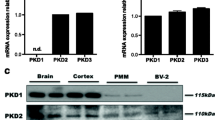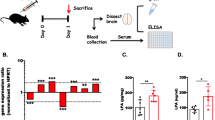Abstract
Microglia play an important role in synaptic pruning and controlled phagocytosis of neuronal cells during developmental stages. However, the mechanisms that regulate these functions are not completely understood. The present study was designed to investigate the role of purinergic signalling in microglial migration and phagocytic activity during post-natal brain development. One-day-old BALB/c mice received lipopolysaccharide (LPS) and/or a purinergic analogue (2-methylthioladenosine-5′-diphosphate; 2MeSADP), intracerebroventrically (i.c.v.). Combined administration of LPS and 2MeSADP resulted in activation of microglia as evident from increased expression of ionised calcium-binding adapter molecule 1 (Iba1). Activated microglia showed increased expression of purinergic receptors (P2Y2, P2Y6 and P2Y12). LPS either alone or in combination with 2MeSADP induced the expression of Na+/Ca2+ exchanger (NCX-1) and P/Q-type Ca2+ channels along with MARCKS-related protein (MRP), which is an integral component of cell migration machinery. In addition, LPS and 2MeSADP administration induced the expression of microglial CD11b and DAP12 (DNAX-activation protein 12), which are known to be involved in phagocytosis of neurons during development. Interestingly, administration of thapsigargin (TG), a specific Ca2+-ATPase inhibitor of endoplasmic reticulum, prevented the LPS/2MeSADP-induced microglial activation and migration by down-regulating the expression of Iba1 and MRP, respectively. Moreover, TG also reduced the LPS/2MeSADP-induced expression of CD11b/DAP12. Taken together, the findings reveal for the first time that Ca2+-mediated purinergic receptors regulate the migration and phagocytic ability of microglia during post-natal brain development.






Similar content being viewed by others
References
Prinz M, Mildner A (2011) Microglia in the CNS: immigrants from another world. Glia 59(2):177–187
Schlegelmilch T, Henke K, Peri F (2011) Microglia in the developing brain: from immunity to behaviour. Curr Opin Neurobiol 21(1):5–10
Inoue K (2002) Microglial activation by purines and pyrimidines. Glia 40(2):156–163
Sasaki Y, Hoshi M, Akazawa C, Nakamura Y, Tsuzuki H, Inoue K, Kohsaka S (2003) Selective expression of Gi/o-coupled ATP receptor P2Y12 in microglia in rat brain. Glia 44(3):242–250
Koizumi S, Shigemoto-Mogami Y, Nasu-Tada K, Shinozaki Y, Ohsawa K, Tsuda M, Joshi BV, Jacobson KA, Kohsaka S, Inoue K (2007) UDP acting at P2Y6 receptors is a mediator of microglial phagocytosis. Nature 446(7139):1091–1095
Davalos D, Grutzendler J, Yang G, Kim JV, Zuo Y, Jung S, Littman DR, Dustin ML, Gan WB (2005) ATP mediates rapid microglial response to local brain injury in vivo. Nat Neurosci 8(6):752–758
Haynes SE, Hollopeter G, Yang G, Kurpius D, Dailey ME, Gan WB, Julius D (2006) The P2Y12 receptor regulates microglial activation by extracellular nucleotides. Nat Neurosci 9(12):1512–1519
Ohsawa K, Irino Y, Nakamura Y, Akazawa C, Inoue K, Kohsaka S (2007) Involvement of P2X4 and P2Y12 receptors in ATP-induced microglial chemotaxis. Glia 55(6):604–616
Avignone E, Ulmann L, Levavasseur F, Rassendren F, Audinat E (2008) Status epilepticus induces a particular microglial activation state characterized by enhanced purinergic signaling. J Neurosci 28(37):9133–9144
Crain JM, Nikodemova M, Watters JJ (2009) Expression of P2 nucleotide receptors varies with age and sex in murine brain microglia. J Neuroinflammation 6:24
Di Virgilio F, Ceruti S, Bramanti P, Abbracchio MP (2009) Purinergic signalling in inflammation of the central nervous system. Trends Neurosci 32(2):79–87
Ulmann L, Levavasseur F, Avignone E, Peyroutou R, Hirbec H, Audinat E, Rassendren F (2013) Involvement of P2X4 receptors in hippocampal microglial activation after status epilepticus. Glia 61(8):1306–1319
Naruse I, Keino H (1995) Apoptosis in the developing CNS. Prog Neurobiol 47(2):135–155
Hashimoto K, Kano M (2005) Postnatal development and synapse elimination of climbing fiber to Purkinje cell projection in the cerebellum. Neurosci Res 53(3):221–228
Smyth JT, Hwang SY, Tomita T, DeHaven WI, Mercer JC, Putney JW (2010) Activation and regulation of store-operated calcium entry. J Cell Mol Med 14(10):2337–2349
Moller T (2002) Calcium signaling in microglial cells. Glia 40(2):184–194
Farber K, Kettenmann H (2006) Functional role of calcium signals for microglial function. Glia 54(7):656–665
Hanisch UK, Kettenmann H (2007) Microglia: active sensor and versatile effector cells in the normal and pathologic brain. Nat Neurosci 10(11):1387–1394
Nimmerjahn A, Kirchhoff F, Helmchen F (2005) Resting microglial cells are highly dynamic surveillants of brain parenchyma in vivo. Science 308(5726):1314–1318
Kettenmann H, Hanisch UK, Noda M, Verkhratsky A (2011) Physiology of microglia. Physiol Rev 91(2):461–553
Larsson C (2006) Protein kinase C and the regulation of the actin cytoskeleton. Cell Signal 18(3):276–284
Blackshear PJ (1993) The MARCKS family of cellular protein kinase C substrates. J Biol Chem 268(3):1501–1504
Arbuzova A, Schmitz AA, Vergeres G (2002) Cross-talk unfolded: MARCKS proteins. Biochem J 362(Pt 1):1–12
Li J, Zhu Z, Bao Z (1996) Role of MacMARCKS in integrin-dependent macrophage spreading and tyrosine phosphorylation of paxillin. J Biol Chem 271(22):12985–12990
Zhou X, Li J (2000) Macrophage-enriched myristoylated alanine-rich C kinase substrate and its phosphorylation is required for the phorbol ester-stimulated diffusion of beta 2 integrin molecules. J Biol Chem 275(26):20217–20222
Cunningham CL, Martinez-Cerdeno V, Noctor SC (2013) Microglia regulate the number of neural precursor cells in the developing cerebral cortex. J Neurosci 33(10):4216–4233
Wakselman S, Bechade C, Roumier A, Bernard D, Triller A, Bessis A (2008) Developmental neuronal death in hippocampus requires the microglial CD11b integrin and DAP12 immunoreceptor. J Neurosci 28(32):8138–8143
Roumier A, Bechade C, Poncer JC, Smalla KH, Tomasello E, Vivier E, Gundelfinger ED, Triller A, Bessis A (2004) Impaired synaptic function in the microglial KARAP/DAP12-deficient mouse. J Neurosci 24(50):11421–11428
Neumann H, Takahashi K (2007) Essential role of the microglial triggering receptor expressed on myeloid cells-2 (TREM2) for central nervous tissue immune homeostasis. J Neuroimmunol 184(1–2):92–99
Glascock JJ, Osman EY, Coady TH, Rose FF, Shababi M, Lorson CL (2011) Delivery of therapeutic agents through intracerebroventricular (ICV) and intravenous (IV) injection in mice. J Vis Exp (56). doi:10.3791/2968
Campbell LR, Pang Y, Ojeda NB, Zheng B, Rhodes PG, Alexander BT (2012) Intracerebral lipopolysaccharide induces neuroinflammatory change and augmented brain injury in growth-restricted neonatal rats. Pediatr Res 71(6):645–652
Lambert C, Ase AR, Seguela P, Antel JP (2010) Distinct migratory and cytokine responses of human microglia and macrophages to ATP. Brain Behav Immun 24(8):1241–1248
Jan CR, Ho CM, Wu SN, Tseng CJ (1999) Mechanism of rise and decay of thapsigargin-evoked calcium signals in MDCK cells. Life Sci 64(4):259–267
Pfaffl MW (2001) A new mathematical model for relative quantification in real-time RT-PCR. Nucleic Acids Res 29(9):e45
Towbin H, Staehelin T, Gordon J (1992) Electrophoretic transfer of proteins from polyacrylamide gels to nitrocellulose sheets: procedure and some applications. Biotechnology 24:145–149
Toescu EC, Moller T, Kettenmann H, Verkhratsky A (1998) Long-term activation of capacitative Ca2+ entry in mouse microglial cells. Neuroscience 86(3):925–935
Moller T, Kann O, Verkhratsky A, Kettenmann H (2000) Activation of mouse microglial cells affects P2 receptor signaling. Brain Res 853(1):49–59
Sunohara JR, Ridgway ND, Cook HW, Byers DM (2001) Regulation of MARCKS and MARCKS-related protein expression in BV-2 microglial cells in response to lipopolysaccharide. J Neurochem 78(3):664–672
Knuesel I, Elliott A, Chen HJ, Mansuy IM, Kennedy MB (2005) A role for synGAP in regulating neuronal apoptosis. Eur J Neurosci 21(3):611–621
Block ML, Zecca L, Hong JS (2007) Microglia-mediated neurotoxicity: uncovering the molecular mechanisms. Nat Rev Neurosci 8(1):57–69
Pei Z, Pang H, Qian L, Yang S, Wang T, Zhang W, Wu X, Dallas S, Wilson B, Reece JM, Miller DS, Hong JS, Block ML (2007) MAC1 mediates LPS-induced production of superoxide by microglia: the role of pattern recognition receptors in dopaminergic neurotoxicity. Glia 55(13):1362–1373
Santos AM, Calvente R, Tassi M, Carrasco MC, Martin-Oliva D, Marin-Teva JL, Navascues J, Cuadros MA (2008) Embryonic and postnatal development of microglial cells in the mouse retina. J Comp Neurol 506(2):224–239
Abbracchio MP, Burnstock G, Verkhratsky A, Zimmermann H (2009) Purinergic signalling in the nervous system: an overview. Trends Neurosci 32(1):19–29
Conde JR, Streit WJ (2006) Microglia in the aging brain. J Neuropathol Exp Neurol 65(3):199–203
Streit WJ, Miller KR, Lopes KO, Njie E (2008) Microglial degeneration in the aging brain—bad news for neurons? Front Biosci 13:3423–3438
Guo RW, Huang L (2008) New insights into the activation mechanism of store-operated calcium channels: roles of STIM and Orai. J Zhejiang Univ Sci B 9(8):591–601
Thastrup O (1990) Role of Ca2(+)-ATPases in regulation of cellular Ca2+ signalling, as studied with the selective microsomal Ca2(+)-ATPase inhibitor, thapsigargin. Agents Actions 29(1–2):8–15
Jan CR, Ho CM, Wu SN, Tseng CJ (1998) Mechanisms of rise and decay of ADP-evoked calcium signal in MDCK cells. Chin J Physiol 41(2):67–73
Hoffmann A, Kann O, Ohlemeyer C, Hanisch UK, Kettenmann H (2003) Elevation of basal intracellular calcium as a central element in the activation of brain macrophages (microglia): suppression of receptor-evoked calcium signaling and control of release function. J Neurosci 23(11):4410–4419
Nagano T, Kawasaki Y, Baba A, Takemura M, Matsuda T (2004) Up-regulation of Na(+)-Ca2+ exchange activity by interferon-gamma in cultured rat microglia. J Neurochem 90(4):784–791
Bravo-Martínez J, Delgado-Coello B, Mas-Oliva J (2010) Cell calcium extrusion systems and their role in epileptogenesis. Open Neurosci J 4:1–12
Kreutzberg GW (1996) Microglia: a sensor for pathological events in the CNS. Trends Neurosci 19(8):312–318
Mocsai A, Abram CL, Jakus Z, Hu Y, Lanier LL, Lowell CA (2006) Integrin signaling in neutrophils and macrophages uses adaptors containing immunoreceptor tyrosine-based activation motifs. Nat Immunol 7(12):1326–1333
Takahashi K, Rochford CD, Neumann H (2005) Clearance of apoptotic neurons without inflammation by microglial triggering receptor expressed on myeloid cells-2. J Exp Med 201(4):647–657
Acknowledgments
This work was supported by Dr. D.S. Kothari Postdoctoral fellowship from the University Grants Commission to A.S. [13-879/2013(BSR)], UGC-SAP and DST-PURSE grants, and Senior research fellowship from Indian Council of Medical Research to S.B. [67/11/2013-Immunology/BMS for].We thank Dr. A.S. Naura for providing primary antibodies, MRP (sc-161829) and DAP12 (sc-166085).
Conflict of Interest
Authors declare that they have no competing conflict of interests.
Author information
Authors and Affiliations
Corresponding author
Electronic supplementary material
Below is the link to the electronic supplementary material.
Supplementary Figure 1
Sites of I.C.V. injection in the ventricles. Pups were immobilized and cryo-anaesthetised for 1-2 min. A sterilized glass micropipette attached to a 5 μl Hamilton syringe through a long tube was used for injecting various drugs. The needle was inserted 2 mm deep at a location approximately 0.25 mm lateral to the sagittal suture, 0.50–0.75 mm rostral to the neonatal coronary suture. (GIF 7 kb)
Rights and permissions
About this article
Cite this article
Sunkaria, A., Bhardwaj, S., Halder, A. et al. Migration and Phagocytic Ability of Activated Microglia During Post-natal Development is Mediated by Calcium-Dependent Purinergic Signalling. Mol Neurobiol 53, 944–954 (2016). https://doi.org/10.1007/s12035-014-9064-3
Received:
Accepted:
Published:
Issue Date:
DOI: https://doi.org/10.1007/s12035-014-9064-3




